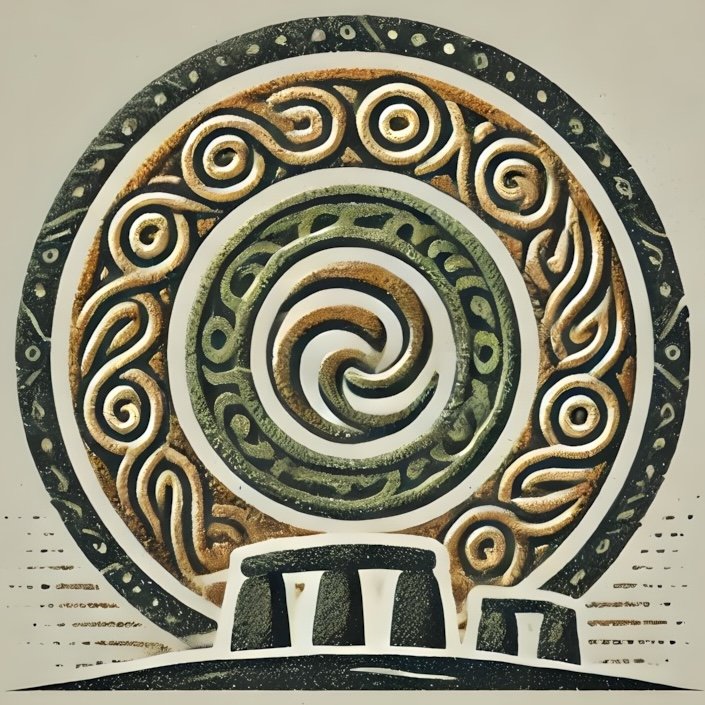# Rituals, Religion, and Society in Irish Prehistory
Ireland’s rich tapestry of prehistory is woven with threads of ritual, religion, and social organization that reveal the profound relationship between its ancient peoples and the landscape they inhabited. This pillar page explores the ceremonial sites that punctuate the Irish landscape, the reverence for ancestors, the cosmic alignments that guided their lives, the art and symbolism that adorned their monuments, and the theories surrounding their social structures. Together, these elements paint a vivid picture of a society deeply connected to its spiritual beliefs and the natural world.
## Ceremonial Sites and Their Possible Functions
The Irish landscape is dotted with an array of ceremonial sites, each steeped in mystery and significance. From the imposing stone circles of the Boyne Valley to the enigmatic passage tombs of Loughcrew, these sites serve as a testament to the spiritual life of ancient communities.
One of the most iconic ceremonial sites is **Newgrange**, a passage tomb built around 3200 BCE. This UNESCO World Heritage Site is not just an architectural marvel but also a cosmic observatory. Each winter solstice, sunlight streams through the entrance passage and illuminates the inner chamber, suggesting that the site was designed for ritualistic purposes tied to the changing seasons. This alignment with celestial events indicates a sophisticated understanding of astronomy and a desire to connect with the divine through the cycles of nature.
Other sites, such as the **Hill of Tara**, served as political and ceremonial centers, where kings were inaugurated and important gatherings took place. The presence of burial mounds, standing stones, and earthworks at these locations suggests that they were not only places of worship but also served as focal points for community identity and cohesion.
## The Role of the Ancestors and Cosmic Alignments
In prehistoric Ireland, the reverence for ancestors played a crucial role in shaping societal beliefs and practices. Ancestors were not merely remembered; they were actively invoked in rituals and ceremonies. The act of burial itself was a significant ritual, with the dead often interred in elaborate tombs adorned with intricate carvings and symbols. This practice reflects a belief in the continuity of life and the importance of maintaining a connection with those who had passed.
The connection to the cosmos is further illustrated by the alignment of many ceremonial sites with celestial events. At Newgrange, the winter solstice alignment signifies a deep understanding of the cycles of the sun, which were integral to agricultural practices and seasonal celebrations. The alignment with the sun may also indicate a belief in the sun as a divine entity, reinforcing the idea that the ancestors were watching over the living, guiding them through the cycles of life and death.
The **Loughcrew Cairns**, another significant site, features alignments that correspond with the equinoxes and other solar events. This suggests that the ancient Irish were not only concerned with the afterlife but also with the rhythms of the natural world, using these celestial markers to inform their agricultural cycles and communal gatherings.
## Art and Symbolism in Megalithic Ireland
Art and symbolism are central to understanding the beliefs and values of prehistoric Irish society. The intricate carvings found on megalithic tombs and standing stones serve as a visual language that conveys complex ideas about spirituality, identity, and the cosmos.
The **spiral motifs**, concentric circles, and zigzag patterns found at sites like Newgrange and Loughcrew are not merely decorative; they are imbued with meaning. Spirals, for instance, may symbolize the journey of life, the cyclical nature of existence, or the connection between the earthly and the divine. These symbols reflect a worldview that embraced the interconnectedness of all things, suggesting that the ancient Irish saw themselves as part of a larger cosmic order.
In addition to these motifs, the presence of anthropomorphic figures and zoomorphic imagery indicates a rich tapestry of beliefs surrounding deities and nature spirits. The carvings may represent gods or goddesses associated with fertility, the harvest, or the natural elements, further emphasizing the importance of nature in their spiritual practices.
The artistry of the megalithic builders also serves as a testament to their skills and creativity, revealing a society that valued craftsmanship and communal effort. The act of creating these monumental structures and their accompanying art was likely a communal endeavor, fostering a sense of identity and belonging among the people.
## Theories on Social Structure
The social structure of prehistoric Ireland remains a topic of ongoing debate among archaeologists and historians. However, several theories have emerged that attempt to explain the organization of these ancient communities.
One prominent theory suggests that society was organized hierarchically, with a ruling elite who oversaw the construction of monumental sites and the conduct of rituals. This elite may have been composed of chieftains or priestly figures who held both political and religious authority. The presence of large ceremonial sites, such as the Hill of Tara, supports this idea, as these locations would have required significant resources and labor to construct.
Another theory posits a more egalitarian society, where communal decision-making and cooperation were key to social organization. The construction of megalithic sites often involved large groups of people working together, suggesting a society that valued collective effort and shared responsibility. This perspective emphasizes the role of ritual and ceremony in fostering social cohesion and identity, rather than strict hierarchies.
Additionally, the evidence of trade and interaction with neighboring cultures indicates that prehistoric Irish society was not isolated but rather engaged in a broader network of exchange. This connectivity may have influenced social structures, as communities interacted and shared ideas, goods, and practices.
## Conclusion
The exploration of rituals, religion, and society in Irish prehistory reveals a complex and interconnected world. The ceremonial sites, reverence for ancestors, cosmic alignments, and rich artistic expressions all point to a society deeply engaged with the spiritual and natural realms. As we continue to uncover the layers of Ireland’s past, we gain a deeper understanding of the beliefs and values that shaped these ancient communities.
For those interested in exploring these themes further, visiting sites like Newgrange, the Hill of Tara, and Loughcrew offers a tangible connection to the rituals and beliefs of our ancestors. Each stone and carving invites us to reflect on the enduring legacy of a society that revered the cosmos, honored its ancestors, and celebrated the beauty of the natural world.
meta – Explore the intertwining of rituals, religion, and society in Irish prehistory. Discover key sites and connect with mythology across Ireland’s rich landscape.

